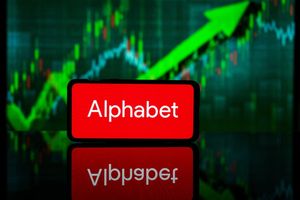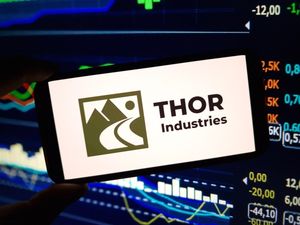
Zcash (ZEC) has stormed back into the cryptocurrency spotlight, boasting an impressive 92% annual price surge, climbing from approximately $29.38 on September 25, 2024, to $56.29 by September 25, 2025. This remarkable rally, which saw the privacy-focused digital asset briefly touch $61.36, signals a powerful resurgence in demand for financial privacy amidst an increasingly scrutinized digital landscape. The surge not only highlights Zcash's enduring appeal as a leading privacy coin but also underscores a broader market shift towards assets offering enhanced anonymity and robust cryptographic security.
This significant upward momentum is driven by a confluence of factors, including strategic technological advancements, a pivotal halving event, growing institutional and retail interest in shielded transactions, and a general bullish sentiment within the altcoin market. As global regulatory bodies intensify their oversight of transparent blockchains, Zcash's core value proposition – enabling truly private transactions via zero-knowledge proofs – resonates deeply with a user base increasingly prioritizing confidentiality. The immediate implications for the wider crypto market include a renewed focus on privacy coins, a confirmation of an ongoing altcoin season, and a complex interplay between persistent market demand for privacy and evolving regulatory tensions.
The Privacy Imperative: Unpacking Zcash's Journey to a 92% Surge
Zcash's recent price explosion is the culmination of a dynamic period marked by strategic development, market catalysts, and a growing recognition of its unique privacy features. Its journey from a cycle low of $15.97 last year to its current trading range around $57-$59 reflects a calculated evolution and a timely response to market demands.
The Zcash halving event in November 2024 was a crucial catalyst. Similar to Bitcoin's (NASDAQ: BTC) pre-programmed supply reductions, Zcash's second halving on November 23, 2024, cut block rewards from 3.125 ZEC to 1.5625 ZEC. Historically, such scarcity-inducing events have preceded significant price appreciation, as evidenced by Zcash's 430% surge after its first halving in 2020. This reduced supply, coupled with sustained demand, laid the groundwork for the current rally.
Technological innovation has been central to Zcash's resurgence. The Electric Coin Company (ECC), the primary developer behind Zcash, and the Zcash Foundation have relentlessly pushed the boundaries of zero-knowledge proof (ZK) technology. Key among these advancements is the Zashi CrossPay feature, rolled out on September 16, 2025. This groundbreaking innovation extends Zcash's zero-knowledge proofs to cross-chain payments, allowing for private transactions on external blockchains via NEAR Protocol (NEAR) Intents, effectively breaking down a long-standing barrier in multi-chain ecosystems. Furthermore, the July 2025 integration with NymVPN has allowed users to pay for anonymous IP obfuscation using shielded ZEC transactions, moving Zcash towards a "full stack" privacy model. These developments have not only enhanced Zcash's utility but have also demonstrated its commitment to a science-backed, decentralized approach to financial privacy.
The market's reaction has been overwhelmingly bullish. Analyst Javon Marks, for instance, maintains an ambitious price target of $308.461, suggesting a potential upside of over 465%. Derivatives markets show strong bullish sentiment, indicated by increased Open Interest and positive funding rates. Major cryptocurrency exchanges such as Binance, HTX (Huobi), KuCoin, Kraken, and MEXC continue to list Zcash, facilitating increased trading activity. Notably, Binance removed Zcash from its "Monitoring Tag" list in July 2025, signaling improved market stability and confidence in the asset. The consistent rise in shielded transaction volume, reaching 3.06 million in September 2025 with a 6% monthly increase, further underscores a persistent user need for privacy amid increasing regulatory scrutiny on transparent blockchains.
Corporate Ripples: Winners and Losers in the Privacy Coin Boom
Zcash's impressive annual surge has sent ripples through the cryptocurrency industry, creating clear winners and posing challenges for others. This renewed interest in privacy-preserving assets has significant implications for various stakeholders, from core development teams to competing blockchain projects and regulatory bodies.
The Winners:
At the forefront of the beneficiaries are the core development entities and their ecosystems. The Electric Coin Company (ECC) and the Zcash Foundation, which receive portions of the Zcash development fund, see their resources amplified. This influx of capital empowers them to further invest in cryptographic research, protocol upgrades (such as the planned transition to Proof-of-Stake), and community initiatives, accelerating Zcash's technological roadmap. Organizations like Zcash Community Grants (ZCG) also benefit, gaining more capital to support community-driven projects that enhance Zcash's utility and adoption.
Cryptocurrency exchanges that list Zcash are experiencing increased trading volumes and associated fee revenues. Major platforms like Binance, Kraken, KuCoin, HTX (Huobi), and MEXC are direct beneficiaries of heightened investor interest and trading activity in ZEC. Similarly, Zcash wallet providers, including prominent software wallets like Guarda Wallet, Atomic Wallet, Trust Wallet, and hardware wallets such as Ledger and Trezor, are seeing increased demand for their secure storage solutions as more users acquire ZEC.
Companies integrating Zcash for payments or services also stand to gain. NymVPN, which integrated shielded ZEC payments for subscriptions in July 2025, exemplifies how Zcash's utility is expanding beyond mere financial transactions. Projects like Maya Protocol are facilitating native Zcash swaps, enhancing its presence in decentralized finance (DeFi), while platforms like BitcoinVN are upgrading their Zcash infrastructure to enable faster and larger ZEC swaps, indicating growing adoption.
Zero-Knowledge Proof (ZKP) technology companies, which underpin Zcash's privacy, are also indirect winners. The surge validates the market's demand for ZKP technology, potentially spurring further investment and innovation in the field, including projects developing Zcash Shielded Assets (ZSA).
The Losers (or those facing increased pressure):
While Zcash's surge highlights a broader interest in privacy, it inevitably intensifies competition within the privacy coin sector. Other privacy-focused cryptocurrencies like Monero (XMR), Dash (DASH), Beldex (BDX), Oasis Network (ROSE), and Firo (FIRO) may face increased pressure to innovate or risk losing market share if Zcash becomes the preferred choice for privacy-conscious users and institutions. Monero, despite its strong market position, could see its lead challenged by Zcash's unique optional transparency features and proactive regulatory engagement.
Centralized financial institutions and regulatory bodies also face increased challenges. A surge in a privacy coin like Zcash often leads to heightened scrutiny from entities concerned with anti-money laundering (AML) and know-your-customer (KYC) compliance. Regulatory bodies like the Financial Action Task Force (FATF) and the USA Securities and Exchange Commission (SEC) may intensify their efforts to regulate privacy-enhancing technologies, potentially leading to delistings or restrictions in certain jurisdictions. This ongoing tension between financial privacy and regulatory oversight remains a significant hurdle for broader integration into traditional finance.
A Broader Lens: Zcash's Surge in the Crypto Tapestry
Zcash's 92% annual price surge is more than just a localized event; it's a significant indicator of broader industry trends, potential ripple effects, and the ongoing tug-of-war between financial privacy and regulatory control. Its performance offers a crucial lens through which to view the evolving landscape of digital assets.
This event strongly affirms a resurgent demand for privacy in the digital age. As digital surveillance and data collection become more pervasive across traditional financial systems and transparent blockchain networks, users are increasingly seeking robust, verifiable privacy solutions. Zcash, with its pioneering zk-SNARKs technology, directly addresses this need, offering a compelling alternative for those prioritizing confidentiality. This trend runs somewhat counter to recent years where privacy coins faced increased delistings due to regulatory concerns, suggesting a market segment that values privacy above all else.
The ripple effects on competitors are multifaceted. While Zcash's surge might draw investment away from purely anonymous coins like Monero (XMR), it could also lift the entire privacy coin sector by bringing renewed attention to the value proposition of privacy-preserving cryptocurrencies. Zcash's unique ability to offer both shielded (private) and transparent transactions provides a strategic advantage, potentially allowing it to navigate regulatory complexities more effectively than its purely opaque counterparts. For its partners, such as those building cross-chain interoperability solutions or integrating Zcash into DeFi platforms, the surge brings increased liquidity and validation, accelerating development and adoption.
From a regulatory and policy perspective, Zcash's rally will almost certainly intensify scrutiny. Governments and intergovernmental bodies like the FATF have consistently expressed concerns about privacy coins facilitating illicit activities. While Zcash has proactively engaged with regulators and developed audit-friendly viewing keys, a significant price increase could reignite debates about financial privacy versus national security. The European Union's proposed Anti-Money Laundering Regulation (AMLR), set to ban anonymous crypto wallets and privacy coins by July 2027, highlights the ongoing regulatory headwinds. Zcash's ability to balance its core privacy features with compliance solutions will be critical in shaping its long-term regulatory trajectory.
Historically, Zcash's performance draws parallels with Bitcoin's (NASDAQ: BTC) post-halving bull runs. Zcash's own 430% surge after its first halving in 2020 provides a precedent for how scarcity, combined with market demand, can drive price. The current surge, following its November 2024 halving, fits into this pattern. Moreover, Zcash's rally occurs amidst a broader "altcoin season," where capital rotates from Bitcoin into large-cap alternatives, indicating a maturing market where specific technological advantages and use cases drive independent rallies beyond Bitcoin's dominance. This period has been compared to the dot-com era, signaling a potential reshaping of economic power dynamics by emerging digital assets. However, like all crypto assets, Zcash remains subject to the inherent volatility of the market, where rapid gains can be followed by significant corrections.
The Road Ahead: Navigating Zcash's Future Trajectory
Zcash's 92% annual price surge positions it at a critical juncture, with both immense opportunities and formidable challenges ahead. The coming months and years will be pivotal in determining whether it can sustain its momentum and solidify its role as a cornerstone of financial privacy in the digital economy.
In the short-term (remainder of 2025), Zcash is expected to maintain its bullish trajectory, with some analysts forecasting prices between $51.47 and $59.83 by year-end, and potentially reaching an average of $90.17. Key factors to watch include the outcome of the crucial Zcash Foundation's November 2025 development fund vote, which will dictate future protocol upgrades, and ZEC's ability to break through technical resistance levels around $60 and then $100. Continued network activity, particularly shielded transaction volume, will also be a strong indicator of sustained user adoption.
Long-term (2026 and beyond), Zcash's future hinges on its ambitious technological roadmap and its strategic navigation of the regulatory landscape. The planned transition from Proof-of-Work (PoW) to Proof-of-Stake (PoS) is a significant strategic pivot. This shift aims to enhance scalability, enable on-chain governance, reduce its environmental footprint, and potentially expand revenue generation through staking. Further upgrades like Halo 2 and the upcoming NU6.1 are set to strengthen privacy guarantees and improve the Orchard shielded address system. Enhanced interoperability, with plans to expand into North and Latin America, coupled with integrations like NymVPN, will broaden Zcash's utility, positioning it as a fundamental component of a comprehensive "privacy stack." Long-term price predictions vary widely, but optimistic forecasts suggest ZEC could reach hundreds, or even thousands, of dollars by 2030, contingent on successful execution of its roadmap and favorable market conditions.
Market opportunities are abundant, primarily driven by the escalating global demand for privacy in an increasingly surveillance-conscious world. Zcash's advanced zk-SNARKs technology positions it to capitalize on this demand, especially in areas like DeFi, cross-border payments, and general financial privacy. Institutional interest in shielded transactions is also a growing opportunity. However, significant challenges remain, with regulatory uncertainty and pressure being the most formidable. The potential for outright bans on privacy coins in certain jurisdictions, as seen with the EU's proposed AMLR, poses a serious threat. Zcash's strategy of offering optional privacy and engaging proactively with regulators is a critical adaptation, but the balance between absolute privacy and regulatory compliance will continue to be a tightrope walk. Competition from other privacy coins like Monero (XMR) and the inherent volatility of the crypto market also present ongoing hurdles.
Potential scenarios include an optimistic growth scenario where Zcash successfully navigates regulatory hurdles, its technological advancements drive widespread adoption of shielded transactions, and strong community support fuels continuous development, leading to substantial long-term price appreciation. Conversely, a regulatory squeeze scenario could see intensified crackdowns limit Zcash's availability on exchanges, hindering adoption and potentially leading to price stagnation or decline. An innovation-driven niche dominance scenario could see Zcash solidify its position as a critical asset within the "privacy stack," attracting users who prioritize confidentiality, even if mainstream adoption remains limited by regulatory concerns.
A Privacy Paradigm Shift: Zcash's Enduring Impact
Zcash's remarkable 92% annual price surge is more than just a fleeting market event; it represents a significant validation of the enduring demand for financial privacy in the digital age. This rally underscores a fundamental shift in market sentiment, where robust privacy-preserving technologies are increasingly recognized as essential tools for individuals and institutions navigating an ever-evolving landscape of digital surveillance and regulatory oversight.
The key takeaways from Zcash's performance are clear: the strategic timing of its halving event, coupled with relentless technological innovation in zero-knowledge proofs and key ecosystem integrations, has created a powerful growth narrative. The market's embrace of Zcash (ZEC) highlights a persistent, global need for confidentiality, positioning it as a leading solution in a world where transparent blockchains are becoming the norm. Its ability to offer both transparent and shielded transactions provides a unique flexibility that may prove crucial in balancing user privacy with the demands of regulatory compliance.
Moving forward, the cryptocurrency market will continue to grapple with the tension between innovation and regulation. Zcash's trajectory will serve as a bellwether for the broader privacy coin sector. While the fundamental demand for privacy is unlikely to wane, the ease with which Zcash can be accessed and utilized will largely depend on its ability to navigate complex legal and regulatory frameworks. The ongoing decentralization of its ecosystem, with multiple teams actively contributing to its development, further strengthens its long-term viability and resilience against external pressures.
The lasting impact of this surge could be a renewed focus on integrating privacy features across the wider crypto market, solidifying Zcash's role as a crucial component for users and institutions prioritizing anonymity. It reinforces the idea that privacy is not merely a niche feature but a fundamental right that can be technologically enforced within decentralized networks.
Investors should closely watch for several key indicators in the coming months. The Zcash Foundation's November 2025 development fund vote is paramount, as its outcome will directly influence future protocol upgrades and ecosystem growth. Progress on Network Upgrade 7 (NU7), particularly the deployment of Zcash Shielded Assets (ZSAs) and efforts towards quantum resilience, will be critical. Furthermore, investors must remain vigilant regarding the global regulatory landscape concerning privacy coins, as policy shifts could significantly impact market access and adoption. Increased shielded transaction adoption and sustained on-chain activity will be strong indicators of Zcash's growing utility. Finally, observing broader market trends, Bitcoin's (NASDAQ: BTC) price action, and the competitive landscape of other privacy-focused cryptocurrencies will provide essential context for ZEC's continued performance.
This content is intended for informational purposes only and is not financial advice.





